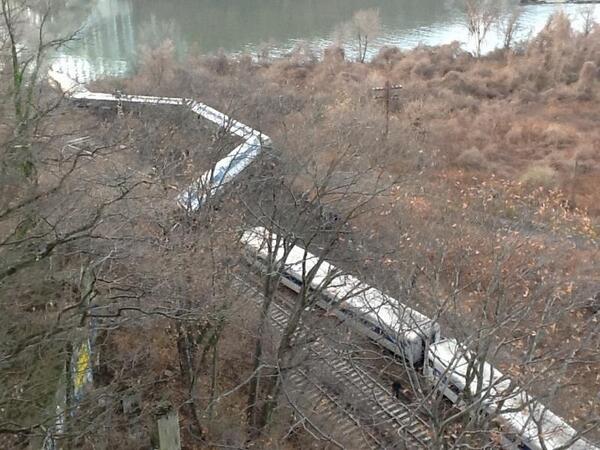
Metro-North Railroad crews at work repairing a damaged section of track near the Spuyten-Duyvil station on Tuesday. Photo: Marc A. Hermann / MTA New York City Transit
There’s something very dramatic and unsettling about seeing a passenger rail train, once filled with people, lying on its side scattered about its tracks and the woods nearby. It’s wrong for a train to be off its track, and it’s newsworthy when one jumps the rails. This past Sunday’s Metro-North derailment provided us with a tragic reminder of the worst that can happen when a train derails, particularly one traveling at excessive speeds.
In the aftermath of the incident, safety takes second stage. Politicians throughout the region issued calls for comprehensive studies and sounded alarm bells. Connecticut Gov. Dan Malloy penned a letter to the MTA. “I am asking MTA/Metro-North to develop an action plan that addresses communication, safety reporting, inspection and maintenance programs, remedial short term action plans, and longer term capital investment programs to upgrade the infrastructure,” he wrote. Change needs to happen now.
New York’s junior senator Kirsten Gillibrand issued a similar call with particularly strident language. She wrote a letter to Federal Railroad Administrator Joseph Szabo expressing “deep concern over the recent derailment of a Metro-North commuter train in the Bronx, and for the safety of New Yorkers and others who use the Metro-North railroad every day.”
“Yesterday’s accident is the latest in a long list of accidents on MTA’s system, and comes on the heels of a freight train derailment near the same turn in July… This is simply unacceptable,” she wrote. “I renew my call for an immediate comprehensive safety evaluation of the MTA system and procedures to ensure that we do not experience a similar tragedy in the future. Additionally, I request that you provide my office with an overview of any steps that have been taken by the FRA to address MTA commuter rail safety.”
What Gillibrand and Malloy are saying has some truth to it, but there’s also some kneejerk fearmongering. Meanwhile, the incident has created the perception of safety problems. One rider said to The Times on Sunday, “You think you’re safe on the train. I know I’m going to be taking a car for a while.”
It’s that reaction that the coverage over the last few days and the statements made by politicians has fed. Sunday’s derailment is a terrible story with a tragic ending for four riders and horrific injuries to many others. These four fatalities though were the first passenger deaths in Metro-North’s 31-year history. WNYC crunched the numbers and found that, since 1993, for every 1 billion train passengers, seven have died. In 2012 alone, 33,561 Americans died in traffic incidents. The comparable motor vehicle death rate is 108,000 for every 1 billion drivers.
Now, I’m not going to further minimize what happened Sunday. Fatalities or not, Metro-North’s safety record, as the FRA noted on Tuesday, has been abysmal of late, and the technology exists to ensure that no one — zero people — dies on in a crash derailment due to excessive speeds. The MTA though hasn’t fully funded the positive train control program and may not have it ready until 2019. That we can build a $4.5 billion subway stop but can’t scrounge up a quarter of that to save lives speaks volumes about our priorities in non-emergency situations. But I digress. (In an excellent post, Patrick at The LIRR Today delves into this issue and more.)
I’d like to know from politicians where the general outrage is when seven pedestrians die in car crashes as they have over the last week in New York City. I’d like to know why it’s a struggle to fund mass transit until something calamitous happens and dramatic photos — of flooded stations, of derailed trains — are splashed across front pages. Investing in transit is a commitment, but it’s well worth it in added mobility and, yes, saved lives. Metro-North needs to improve its safety record, and it likely has to overcome a brain drain. But it needs support from start to finish and not just at the end.


